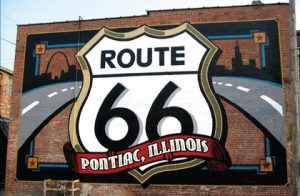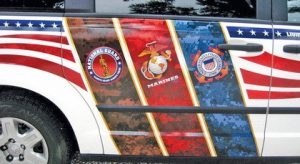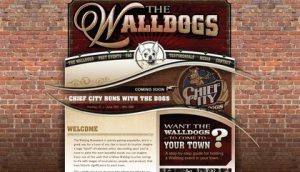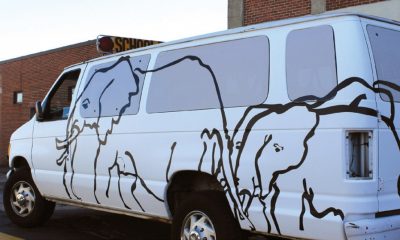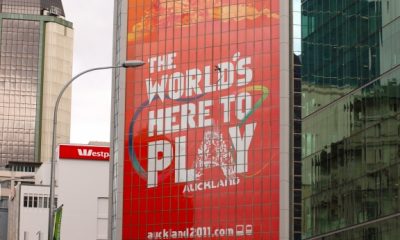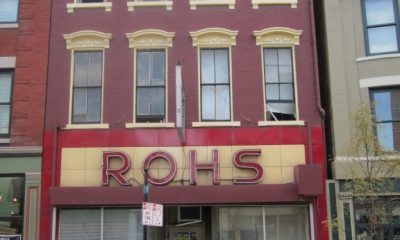News
Getting Their Kicks
Thriving in a small town on Route 66 suits multi-faceted Diaz Sign Art.
Published
15 years agoon
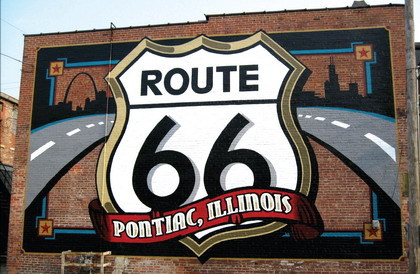
In honor of November’s presidential election, ST is profiling a signshop from the state represented by the victorious candidate. Given President-elect Barack Obama’s (D-IL) victory, we’ve selected Diaz Sign Art to represent the Land of Lincoln.
Life in contemporary, small-town America can be tough. Most factories and mills that once functioned as the lifeblood of such communities have shuttered their facilities or mandated major cutbacks in staffing or worker salaries and benefits. And, although the Information Age theoretically connects everyone from coast to coast, large urban centers possess the greatest technological amenities and 21st-century economic opportunities that attract Gen-Xers and younger.
However, U.S. socioeconomic trends don’t worry the Diaz family – father Bill, wife Jane and sons Ben and Joe – that’s operated Pontiac, IL’s Diaz Sign Art for more than 30 years. Although Pontiac isn’t immune to tough times, the Diazes have adapted their business to changing times. They’ve expanded their coverage area, played several roles in promoting their community’s image and legacy, and are branching out their business to accommodate new technological demands. However, the foundation of the family business, vehicle graphics, remains prominent to its bottom line.
Good timing
Bill says the family entered the sign business somewhat by accident. “I’d earned my master of fine arts degree, and was looking to become a teacher,” he said. “While waiting for positions to open, I worked for a builder designing homes and painting and decorating their interiors. I decided I liked this, and, around this time [in the late ’70s], our local signmaker closed his shop and moved to Arizona. People knew I had an artistic background and began calling on me to make signs, and pinstripe and decorate vehicles.”
AdvertisementBill decided he enjoyed making signs and, by the early ’80s, devoted his shop solely to fabricating MDO and painted-metal signage, and vehicle graphics. In Diaz Sign Art’s early days, the shop primarily fabricated handpainted signage and pinstripes and graphics commercial trucks and semi trailers. Since, Diaz Sign Art has abandoned MDO for such reliable substrates as HDU, Nudo Products’ AlumaCorr® and other, composite-material panels. Sandblasting and glue-chipping are among the shop’s varied fabrication techniques.
The real estate maxim of “location, location, location” worked in the Diazes’ favor. Bill said, “Route 66 runs right through Pontiac, so tourism is a key component to our local economy. We’re also situated right off of I-55, between Chicago and St. Louis, so truckers driving that route who’ve heard we do good work will stop in and get their truck graphics updated.”
In the late ‘80s, when operating the entire business consumed too much of Bill’s time and energy, he persuaded Jane to leave her job as an art teacher to handle the shop’s accounting.
“She decides whether we get a new toy for the shop,” Bill quipped.
Growing business
Eventually, Ben and Joe became involved with the shop as they grew into adulthood. Ben, who’s the shop’s jack-of-all-trades (and, according to Bill, equally proficient with vinyl-lettering application, administrative tasks and website design), became a full-time shop employee two years ago, and Joe, who’s a talented signmaker but primarily focuses his energy to website development and management, became involved approximately three years ago. Before joining the family business, both sons began their careers with Bloomington, IL’s Prairie Signs.
AdvertisementAlthough Bill estimates vehicle graphics’ share of shop business has decreased from roughly 70% to approximately 40%, they still represent the largest component. Inside the shop’s two buildings, a 1,200-sq.-ft. shop and a 1,000-sq.-ft. office area, the Diazes produce these graphics using a Graphtec FC-5100-75 30-in. cutting plotter and 30-in. Roland VersaCAMM SP-300V eco-solvent-ink printer/plotter. For most jobs, the shop uses 3M’s or Oracal’s cast film.
The family has laid out the shop so that one room houses the shop’s four PCs and one Mac® and vinyl-printing and plotting, and customer-waiting area, while the garage/shop houses the vehicle-decoration, painting, woodworking and metalworking areas.
“We think it makes our operation more efficient to separate clean work from dirty,” Bill said.
However, the fortunes of the automotive industry in general, and trucking in particular, can impact Diaz Sign Art’s volume of vehicle-graphics work.
“The escalation of the price of diesel fuel has put a lot of smaller owner-operators out of business,” Bill said. “Also, when new tractor-trailer or body types are announced, or new emission specs are introduced, there’s a rush to buy out the old models before the changes are instituted. Then, business slows down once the new models or regulations are introduced.”
AdvertisementBuilt to last
Pontiac likely faces trying economic times. At presstime, the city was slated to lose its second-largest employer, the Pontiac Correctional Center – which provided 600 jobs for a city of approximately 12,000 – by year’s end. Following the rule-of-thumb that one job lost at a major employer triggers the demise of three more complementary livelihoods, this bodes poorly for the town.
The Diazes are preparing themselves on several levels. First, the shop is broadening its coverage area; Bill said the shop now services businesses within a 100-mile radius, which now gets them work in Chicago’s South Side suburbs.
“When truckers change freight companies or go on their own, they tend to remember our work and call us to decorate their new trucks,” Bill said. “If a company has three or more identical vehicles to decorate, Ben and I will come to them.”
Most of these jobs comprise printed, high-performance, laminated cast vinyl. For jobs that require pinstriping, they use House of Kolor (HOK) urethane striping enamels. Bill said reformulations with traditional lettering enamels required the change.
Second, they’ve capitalized on Pontiac’s historic legacy. The Diazes have partnered with Pontiac’s Illinois Route 66 museum, which opened three years ago. For the museum’s opening, they painted an exterior brick wall with a road-themed mural that features a 30 x 40-ft. Route 66 shield (the world’s largest depiction of the Route 66 icon). They’ve also fabricated various sign programs for the museum.
Like many small, historic towns, Pontiac has strict codes that mandate a tight ratio of store frontage to allowable signage square footage, and it tightly regulates illuminated signage. However, familiarity and respect for the rules smoothes the Diazes’ dealings with city hall.
“We’ve never been turned down for a sign permit,” Bill said. “It’s important to play by the rules to stay on good terms with those who approve your signs.”
E-conomy
Rather than clinging to the status quo and relegating the shop’s fortune to the mercy of fickle economic forces, Diaz Sign Art has embraced e-commerce. When Joe joined the shop, he convinced Bill to allow him to introduce website design as one of the shop’s services.
Wisely, he’s targeted signshops for a large percentage of his work. Although most signshops owners are now relatively techno-savvy, Joe said many owners lack the time, resources or patience to develop their own websites. It helps that he understands a shop’s marketing needs.
“Sure, signshop owner will want to discuss the materials he uses, and might want to relay the shop’s history, but a signshop’s website should revolve around its portfolio,” Joe said. “You’ve got to show potential customers what you can, and can’t, do.”
Although entrepreneurs sometimes differentiate themselves through specialization, the current inclination towards one-stop “Wal-Mart” shopping presents the best opportunity for the versatile signshop.
“Anyone who specializes too much runs a risk of cutting off too many potential customers,” Bill said. “In today’s competitive market, it’s important to do everything you can for customer. You don’t want him to leave your shop and go somewhere else if he doesn’t have to.”

SPONSORED VIDEO
Introducing the Sign Industry Podcast
The Sign Industry Podcast is a platform for every sign person out there — from the old-timers who bent neon and hand-lettered boats to those venturing into new technologies — we want to get their stories out for everyone to hear. Come join us and listen to stories, learn tricks or techniques, and get insights of what’s to come. We are the world’s second oldest profession. The folks who started the world’s oldest profession needed a sign.
You may like

INX Promotes Three to Vice President

6 Sports Venue Signs Deserving a Standing Ovation

Hiring Practices and Roles for Women in Sign Companies
Subscribe

Bulletins
Get the most important news and business ideas from Signs of the Times magazine's news bulletin.
Most Popular
-

 Tip Sheet4 days ago
Tip Sheet4 days agoAlways Brand Yourself and Wear Fewer Hats — Two of April’s Sign Tips
-

 Business Management2 weeks ago
Business Management2 weeks agoWhen Should Sign Companies Hire Salespeople or Fire Customers?
-

 Women in Signs2 weeks ago
Women in Signs2 weeks ago2024 Women in Signs Award Winners Excel in Diverse Roles
-

 Real Deal5 days ago
Real Deal5 days agoA Woman Sign Company Owner Confronts a Sexist Wholesaler
-

 Benchmarks21 hours ago
Benchmarks21 hours ago6 Sports Venue Signs Deserving a Standing Ovation
-

 Editor's Note1 week ago
Editor's Note1 week agoWhy We Still Need the Women in Signs Award
-

 Line Time2 weeks ago
Line Time2 weeks agoOne Less Thing to Do for Sign Customers
-

 Product Buying + Technology1 week ago
Product Buying + Technology1 week agoADA Signs and More Uses for Engraving Machines
